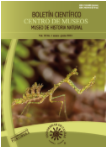Authors
Abstract
The behavior of Sylvilagus brasiliensis in the tropical dry forest of the department of Tolima, has not been studied. The objective of this study was to evaluate the behavior of Sylvilagus in captivity. They were used two Leporidae which were housed in natural conditions acclimated to individual pens. Data were collected for five consecutive days at intervals of five minutes, with one minute of observation through video cameras, identifying variables rest, sleep, tossing and turning, crack, drinking, eating, urinating, defecating, cecotrophy and grooming. We found that Sylvilagus brasiliensis have nocturnal habits behavior, due to the high percentage of activities in this period, and during the day the animals were devoted to rest and sleep.
Keywords
References
CAMPS, J., 1997.- Importancia de la etología para mejorar el manejo de los conejos. Cunicultura, 22 (129): 247-251.
CARABAÑO, R. & MERINO, J.M., 1996.- Effect of ileal cannulation on feed intake, soft and hard faecs excretion throughout the day in rabbits: 121-126 (en) Proceedings 6th World Rabbit Congress. Toulouse.
CHAMORRO, D. & GALLO, J.E., 1998.- Gramíneas y Leguminosas. El Poira, Ibagué.
CLARENCE, M.F., 1996.- Manual Merck de Veterinaria. Editora Roca, São Paulo.
COPERRINDER, A., BOYD, R.J. & STUART, H.R., 1986.- Inventory and monitoring of wildlife habitat. Service Center, Denver.
DE BLAS, J.C., GARCÍA, J. & CARABAÑO, R., 2002.- Avances en nutrición de conejos. Revisión a las principales peculiaridades del sistema digestivo de los conejos, que son responsables, entre otras causas, de la complejidad de esta producción. Boletín de Cunicultura, 122: 6-16.
DURANT, P. & PÉREZ R., 1988.- Distribución geográfica y ecológica de los conejos silvestres de Venezuela. El conejo de páramo y el conejo de monte. Monog., CDCHT-ULA. Mérida, Venezuela.
EISENBERG, J. & REDFORD, K., 1999.- Mammals of the Neotropics. The Central Neotropics. Ecuador, Peru, Bolivia, Brazil. Chicago and London: The University of Chicago Press.
FAO, 1986.- El conejo: cría y patología. Organización de las Naciones Unidas para la Agricultura y la Alimentación. Recuperado de http://www.fao.org/docrep/014/t1690s/t1690s02.pdf.
GONZÁLEZ-REDONDO, P., 2006.- Viabilidad de la producción intensiva del conejo de monte en pureza. Ganadería, 38: 50-54.
GUTIÉRREZ, R.P., SAUQUILLO, J. & TORRES, A., 2006.- La iluminación en las granjas cunícolas (1ra Parte). Boletín de Cunicultura, 145: 6-11.
INSUASTY OSORIO, J.A., RAMÍREZ BENAVIDES, G.F. & MEJÍA MORALES, L.M., 2008.- Estudio epidemiológico del conejo silvestre Sylvilagus brasiliensis en el parque nacional natural los nevados. Bol. cient. mus. hist. nat., 12, 90-110.
MAFFEI, L., CUÉLLAR, E. & NOSS, A., 2002.- Uso de trampas-cámara para la evaluación de mamíferos en el ecotono Chaco-Chiquitanía. Revista Biología Ecología, 11: 55-65.
SAMOGGIA, G., 1985.- Actitudes y comportamiento del conejo. Bol. Cunicult., 72.
VALERO, L. & DURANT, P., 2001.- Análisis de la dieta del conejo de páramo, S. brasiliensis meridensis Thomas, 1904 (Lagomorpha: Leporidae) en Mucubaji, Mérida, Venezuela. Revista de Ecología Latino Americana, 8 (2): 1-13.
XU, H.T., 1996.- El comportamiento del conejo. 6th World Rabbit Congress. Toulouse: 329-332.

 PDF (Español)
PDF (Español)
 FLIP
FLIP






















